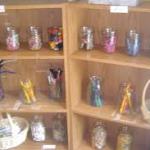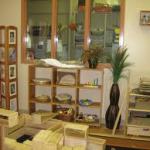All too often our childcare environments are full of bright colours, plastic toys and containers and art work strung from the ceiling. There is an element of “visual chaos” occurring where environments become too over stimulating for the child in a non-meaningful way.
Think about your service’s environment, look at the aesthetics of the room, take note of the main colours in the room, the furniture, the resources, how are they displayed? How is the children’s work displayed? Do you consider your environment to be part of your curriculum?
If you want to reflect the principles of the Early Years Learning Framework (EYLF) then you need to reflect on your environment, you need to see it as part of your curriculum, you need to start thinking about how to present things in a meaningful manner.
Tips for a More Effective EYLF Environment
A great starting point is to remove all plastic containers and replace these with woven baskets. Provide children with choice in each learning area and add interesting items such as pine cones, leaves, material, clip boards, paper and pencils to the block / construction area, or add scissors, glue, paint, tape, paper and collage items to the art area. Place a bunch of flowers, bowl of shells or autumn leaves on the writing table to start a discussion or some still life drawing, or add art work by Picasso to your painting area.
Think about the way you display children’s work. Try to avoid hanging it haphazzardly from the ceiling. Instead place work in frames and place around the room on the wall / shelving, take photos of children engaged in their work and display the photos as well as a reflection of their learning, display group work such as canvas paintings. Provide opportunity for children to leave and re-visit their work such as constructions, clay and doh, collages etc by having a display shelf or space in the room.
 Think now about how you set up your EYLF play areas
Think now about how you set up your EYLF play areas
- Does the room look inviting?
- Are resources of good quality?
- Is there enough for children to use?
- When you are creating inviting places where children’s learning is to be fostered, think about “how can I provide opportunities for the child in this play space?”
- Set up your environment in a way that may encourage further discussion, thinking, play, sharing of ideas.
How does your environment reflect cultural diversity in a respectful and meaningful way?
- Does it reflect the cultures of your families and staff? Does it reflect different world views?
- Are children exposed to this daily or only on special occasions?
- Think about how you can reflect cultural diversity and cultural competence in your day to day curriculum- think about your resources, displays, books, music and instruments, songs and games.
- Think about how families are welcomed and encouraged to participate. Remember, culture does not just refer to those from a culture different to your own… every family has their own culture- their values, beliefs, what and how they celebrate special events…
As educators, it is up to us to ensure that the environment becomes the “3rd teacher” and that children are inspired, excited and curious about their environment.